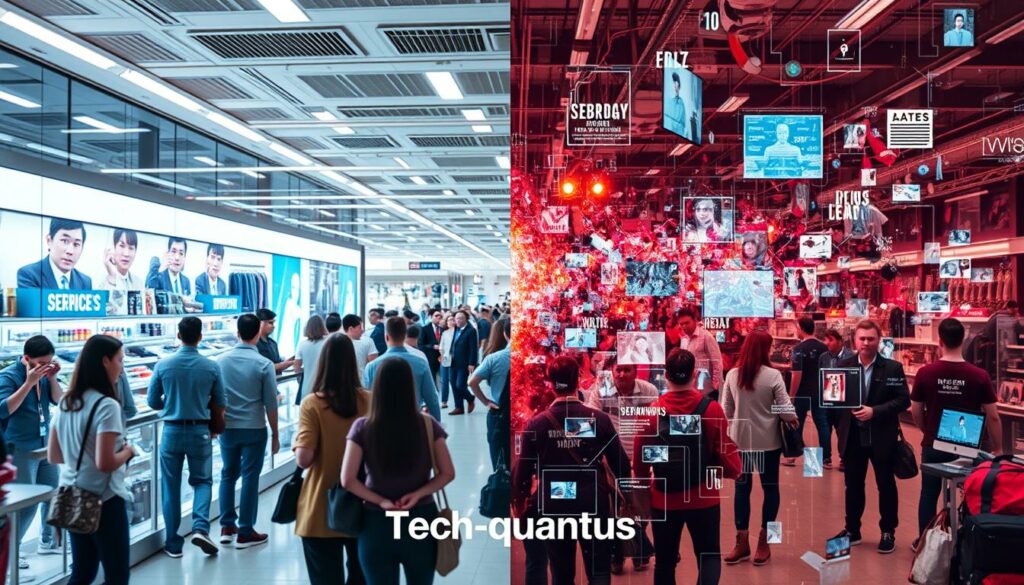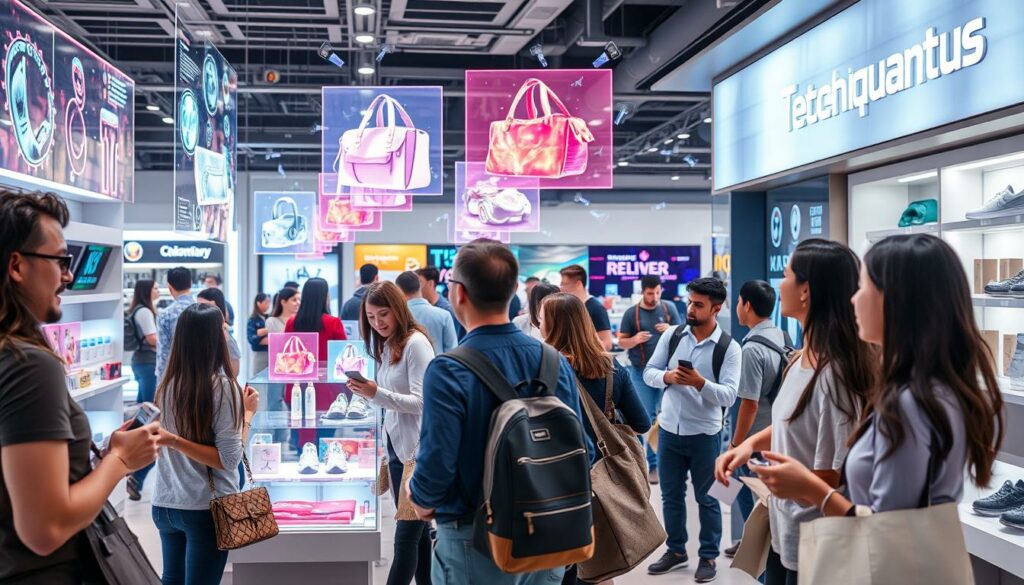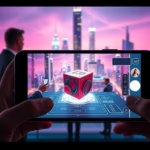Did you know the global mixed reality market is set to hit $58.3 billion by 2030? This growth shows how Augmented Reality (AR) is becoming a big deal in retail. Retailers use AR to make shopping fun and engaging, combining digital and real-life experiences.
AR is more than a trend; it’s key for reaching customers and making shopping better. By using AR, you can make your brand pop and keep customers happy. Let’s look at how AR technologies can change your marketing game.
AR can make shopping easier and let customers try things on virtually. As you read on, you’ll see how AR can boost your marketing and sales. You’ll learn about its many uses, benefits, tools, and what the future holds for AR in retail.
Key Takeaways
- The global mixed reality market is expected to reach $58.3 billion by 2030.
- AR offers unique, immersive shopping experiences that engage consumers effectively.
- Utilizing AR can help retailers compete in a crowded market.
- Technologies like AR are reshaping the future of consumer interaction.
- Understanding your customer is key to successfully implementing AR in retail.
- Brands can differentiate themselves with the innovative use of AR marketing tools.
Understanding Augmented Reality in Retail
Augmented reality (AR) has changed how retailers talk to their customers. It’s a tech that adds digital info to the real world, making things more fun. Retailers love it because it helps them connect with customers and show off their products.
One big way AR applications in retail work is through virtual try-ons. Customers can see how clothes or accessories will look on them without actually wearing them. This makes shopping more fun and helps people make better choices.
Interactive product demos also play a big role. They make products stand out and help customers see what makes them special. This is especially useful in fashion, beauty, and home decor.
The market for AR is booming, expected to hit $58.3 billion by 2030. Big names like Meta and Apple are leading the charge. Customers are getting more into AR, which means retailers that use it can draw in more shoppers and sell more.
AR is still growing and getting more important in retail. Think about how you can use it to stand out. Being early to adopt AR can bring in tech-savvy shoppers and make shopping more fun.
Benefits of Implementing Augmented Reality
Using augmented reality (AR) in retail marketing has many benefits. It changes how we shop. Knowing how AR works is key to better customer interactions and more sales.
Enhancing Customer Engagement
AR makes shopping more engaging. It lets customers see products in new ways. They can see how things fit into their lives, making a stronger bond.
Features like trying items virtually or seeing product details on screens keep customers interested. This makes shopping more fun and interactive.
Increasing Sales Conversion Rates
AR in marketing boosts sales a lot. Studies show that using AR leads to more purchases. It raises the chance of buying something.
AR also helps reduce returns. It gives clear information, helping customers make better choices. This leads to more positive buying habits.
Providing Immersive Shopping Experiences
AR offers immersive shopping experiences. It lets customers explore products in new ways. This is something traditional shopping can’t do.
With AR, shoppers can see and feel products without being in a store. These unique experiences create strong brand loyalty. Customers are more likely to come back and tell others about it.
Popular Augmented Reality Marketing Tools
Augmented reality (AR) is changing how we shop, making the experience better and more engaging. When looking at AR marketing tools, knowing the top AR platforms can boost your marketing. These platforms help customers see products in real-time before they buy.
Overview of Top AR Platforms
Leading AR platforms are making a big impact in retail marketing. Here are some:
- Snapchat Lens: Uses AR to add filters, making brands more memorable and engaging.
- IKEA Place: Lets customers see furniture in their homes before buying, helping them make better choices.
- Google ARCore: Gives developers tools to create AR experiences on Android devices.
- Apple ARKit: Helps developers make AR apps for iOS, reaching Apple’s wide user base.
Using AR marketing tools can grab more customer interest. The global mixed reality market is expected to hit $58.3 billion by 2030. Brands like MixRift show how AR can enhance gaming and reach new customers.
Cost-effective Solutions for Small Businesses
For small businesses, finding affordable AR solutions is key. Here are some budget-friendly options:
- Blippar: Makes creating AR content easy, with no steep learning curve.
- ZapWorks: Offers a full AR development suite with prices for all business sizes.
- Unity: Free for creating AR experiences, great for businesses wanting to innovate without big costs.
These tools help small retailers use AR without breaking the bank. As AR grows, having the right tools will put your brand ahead in a changing market.
| Platform | Key Features | Best for |
|---|---|---|
| Snapchat Lens | Interactive filters and games | Brand engagement |
| IKEA Place | 3D furniture visualization | Home décor |
| Blippar | User-friendly AR creation | Small businesses |
| ZapWorks | All-in-one AR solution | Creatives and businesses |
Case Studies: Successful Augmented Reality Applications
Looking into AR case studies shows how big brands use augmented reality in their marketing. Nike and L’Oreal have used AR to change their brands and engage customers better. These examples show how AR technology and customer interaction can lead to great results.
How Major Brands Transform Retail with AR
Nike changed how people see products with its AR shoes. Customers can try on shoes virtually, making shopping online feel like being in a store. L’Oreal’s virtual makeup try-on lets customers test products before buying. These examples show big steps forward in engaging customers and building brand loyalty.
Innovative AR Campaigns in Action
Many AR campaigns show new ways to connect with customers. For instance, using sensors to improve 3D object detection makes shopping more immersive. This tech is also used in self-driving cars and robots, but it’s really changing retail. The success of these brands shows how AR can give a competitive edge. For more on AR and its effects, check out this link.
Integrating Augmented Reality into Your Marketing Strategy
Augmented reality can boost your retail marketing when used well. Knowing who you want to reach is key to making AR experiences that hit the mark. Brands that match their AR with what customers like see better results. Choosing the right AR tools also makes your brand stand out and leaves a lasting impression.
Identifying Your Target Audience
Finding out who your audience is is crucial for AR marketing. Think about who they are, what they like, and how tech-savvy they are. Surveys and research help you understand what they want, helping you make AR that speaks to them. When AR matches what your audience cares about, they interact more, buy more, and stick with your brand.
Choosing the Right AR Features for Your Brand
AR has many options, like virtual try-ons for makeup or tools to help find items in stores. Picking the best ones for your brand makes a big difference. For instance:
- Virtual fitting rooms let shoppers try clothes without actually wearing them, just like in a store.
- Interactive product demonstrations make customers more engaged by showing how products work in a fun way.
- Spatial mapping helps customers navigate big stores easily, making it simpler to find what they need.
Using these AR features can make shopping smoother and more enjoyable. As more people get into AR, it’s clear it’s a big opportunity for brands to stand out and grab attention.
Challenges and Considerations for AR in Retail
Using augmented reality in retail comes with its own set of challenges. It’s important for businesses to understand these issues to create engaging marketing experiences. The main concerns are technical limitations and the cost of AR. Knowing about these will help you make better decisions for your AR strategy.
Technical Limitations and User Experience
Technical issues can affect how well augmented reality works. Problems like device compatibility, processing power, and internet speed can make things tough for users. For instance:
- Many AR apps need high-end devices, leaving users with older phones out.
- AR experiences can be slow or stop working if the internet is slow.
- It’s important to have easy-to-use interfaces so users can enjoy AR without getting confused.

Cost Implications and Resource Allocation
Costs play a big role in how businesses use AR. The initial cost can be high, which might stop smaller companies from using AR. Important costs include:
- Creating custom AR experiences can be expensive, needing skilled developers and designers.
- Keeping AR apps up-to-date costs money and is necessary for them to work right.
- Training staff to use AR tools costs more and should be planned for.
By understanding these AR challenges, businesses can plan better. This helps them make the most of augmented reality in their marketing.
Future Trends in Augmented Reality for Retail
Augmented reality is changing the way we shop. We’ll see many new trends in AR soon. One big change is using AI with AR. This makes shopping more personal and helps brands understand what customers like.
Brands use AI to give better recommendations. This makes customers happier. They can also predict what people will want, helping them plan better.
The Role of AI in Augmented Reality
AI is key in AR now. It helps make shopping fit what each person likes. This makes shopping more fun and helps brands know what to stock.
AI in AR also makes shopping easier and more fun. It creates better ways to interact with products.
Expanding Beyond Traditional Retail
AR is being used in more areas than just shopping. It’s changing education, real estate, and tourism. In education, AR makes learning fun and interactive.
Real estate agents use AR for virtual tours. This lets people see homes without visiting them. Tourism uses AR to give visitors more information about places.
These new uses for AR open up more chances for brands. They make experiences better in many areas.
Looking into these AR trends can help you stand out in marketing. Using AI in AR and trying new things can attract more customers and boost sales.
Augmented Reality and Consumer Behavior
Shopping habits are changing, and augmented reality (AR) is a big part of that. AR goes beyond old-school shopping, offering new ways that appeal to tech-savvy shoppers. It makes shopping more engaging and interactive, which is what today’s consumers want.
Changing Shopping Preferences in the Digital Age
Now, shoppers want things to be easy and tailored to them. AR lets you see products in new ways, making shopping more fun and efficient. For instance, AR apps let you try on clothes virtually, making it easier to decide what to buy.
This change meets the needs of a market that loves digital ease and fun. It’s like how Target’s Drive Up service with CarPlay makes shopping smooth and gives you tips based on what you buy.
Building Loyalty Through Interactive Experiences
AR apps create a special bond with customers, changing how they shop. They make shopping more engaging and personal, which keeps customers coming back. Brands that use AR to connect with customers build strong loyalty.
Working with Apple, Target shows how digital tools can make shopping better. These tools make customers happy and keep them loyal.

How to Measure the Impact of AR Marketing
Measuring AR marketing’s success needs a clear plan. It’s key to pick the right metrics to see how AR affects your business. By tracking important signs, you can see how users engage and convert, proving AR’s value in your marketing. Measuring AR impact helps you improve your strategies over time.
Important Metrics to Track
To check how well your AR campaigns do, look at these key AR marketing metrics:
- User Engagement: Keep an eye on how long people stick with AR features to see their interest.
- Conversion Rates: See how AR changes customers’ buying choices.
- Return on Investment (ROI): Look at the money earned against what it cost to market.
- Customer Feedback: Get feedback to make AR better in the future.
- Retention Rates: Watch how often customers come back to show loyalty and happiness.
Evaluating ROI: Success Stories
Looking at ROI in AR marketing means checking out real examples. Many companies have used AR and seen big financial gains. For example, a famous furniture store made an AR app that let customers see products at home, boosting sales a lot. This ROI evaluation shows how well AR works, making a strong case for businesses to use this new marketing tool.
Implementation Roadmap for Retailers
Retailers looking to boost customer experiences should consider augmented reality (AR) technology. An AR implementation roadmap helps guide you through the steps to start with AR. It helps set clear goals and understand the market.
Steps to Get Started with AR Technology
Start by setting clear goals for your AR project. Think about what you want to achieve, like boosting sales or engaging customers more. Then, research the latest AR trends and what customers like.
- Define Objectives: Clarify what you want to accomplish.
- Conduct Market Research: Analyze successful AR applications and consumer behaviors.
- Select Appropriate Tools: Choose AR tools that align with your goals.
- Test and Iterate: Continuously refine your AR experiences based on feedback.
Following these steps will help you successfully adopt AR.
Collaborating with AR Developers and Designers
Working with skilled AR developers and designers can greatly improve your project. They bring technical know-how and experience to the table. This ensures your AR solutions are engaging and hit the mark.
When working with experts, look at how others have done it well. For example, JFK International Airport Terminal 4 uses technology like Google Indoor live view and self-service kiosks. This shows how strategic partnerships can make operations better and improve customer experiences. For more on this, check out this insightful article.
In conclusion, a well-planned AR approach and working with AR pros can boost your marketing and improve customer interactions.
Conclusion
Augmented reality (AR) is more than a trend; it’s changing how we market. Retailers use AR to make shopping fun and engaging. This lets customers interact with products in new ways.
Looking ahead, it’s key for brands to keep up with new tech and trends. Using AR, retailers can stand out and offer unique shopping experiences. This way, you meet and beat what customers expect.
AR is vital for retailers wanting to succeed in the fast-changing digital world. Working with skilled developers can help create amazing AR experiences. These experiences will grab your audience’s attention and make them loyal customers. For more on how AI can help your business, check out this page.
FAQ
What is Augmented Reality (AR) in retail?
AR in retail uses digital info to make real-world shopping better. It lets customers try on virtual clothes and see products in new ways. This makes shopping more fun and interactive.
How does AR enhance customer engagement?
AR makes shopping exciting by adding virtual try-ons and cool demos. Customers get to explore products in a new way. This grabs their attention and makes them want to learn more.
What are the benefits of integrating AR into retail marketing?
AR in marketing boosts customer interest and sales. It creates memorable shopping experiences. This builds brand loyalty and cuts down on returns.
What are some popular AR marketing tools?
Top AR tools include Snapchat Lens and IKEA Place. They help businesses create fun AR experiences. There are also affordable AR options for small businesses.
Can you provide examples of successful AR applications in retail?
Big names like Nike and L’Oreal use AR well. Nike shows off shoes virtually, and L’Oreal lets customers try makeup online. These efforts change how customers interact with brands.
What challenges might retailers face when implementing AR?
Retailers might struggle with tech issues, compatibility problems, and making sure users like it. They also worry about costs. Overcoming these hurdles is key to success.
What future trends can we expect in AR for retail?
AR will get smarter with AI to make shopping more personal. It will also spread to new areas like education and tourism. This will change how we use AR in many fields.
How does AR influence consumer behavior?
AR meets today’s shopping needs by offering unique experiences. It draws in tech-loving shoppers and builds loyalty through memorable brand moments.
How can retailers measure the impact of their AR marketing initiatives?
Stores can track AR success by looking at user numbers and sales. Learning from real success stories helps them fine-tune their AR plans.
What are the essential steps for implementing AR in retail?
To add AR to retail, set clear goals, research the market, know your audience, and pick the right AR tools. Working with AR pros can also make your project better and more effective.
Source Links
- https://europeangaming.eu/portal/latest-news/2024/09/09/166154/exclusive-qa-w-bobby-voicu-ceo-and-founder-mixrift/
- https://www.internationalairportreview.com/article/222171/enhancing-passenger-experience-through-technological-innovation/
- https://www.openpr.com/news/3648817/online-fashion-retail-global-market-forecasted-to-reach-86-62
- https://www.opensourceforu.com/2024/09/the-best-open-source-platforms-for-no-code-development/
- https://www.trendhunter.com/protrends/skincare-pod1
- https://www.mdpi.com/1424-8220/24/17/5841
- https://www.mdpi.com/2076-3387/14/9/210
- https://medium.com/@zybie68/the-ultimate-guide-to-artificial-intelligence-what-you-need-to-know-for-the-future-371f5ac49ea3
- https://www.openpr.com/news/3649048/digital-artwork-market-to-surge-to-12-1-billion-trends
- https://www.openpr.com/news/3648849/home-shopping-market-2024-2033-market-size-top-segments
- https://applemagazine.com/carplay-convenience-target-drive/68394
- https://www.dailysabah.com/turkiye/2024-2025-school-year-to-begin-with-new-curriculum-in-turkiye/news
- https://www.opensourceforu.com/2024/09/open-source-providing-pathways-to-professional-growth/
- https://www.opensourceforu.com/2024/09/popular-free-platforms-for-developing-ai-chatbots/
- https://www.americanmachinist.com/shop-operations/article/55138471/the-future-of-trade-shows-virtual-events-and-online-marketing-for-manufacturing-tech-machine-shop-marketing
- https://www.ey.com/en_ph/insights/tmt/how-can-you-realize-the-promise-of-transformational-technologies
- https://www.linkedin.com/posts/ayesha-f-4867a8161_dataanalysis-data-dataengineering-activity-7238731566728765441-EzhW
- https://www.newstrail.com/openai-chatgpt-users-surge-to-200-million-amazon-wimi-accelerates-development-in-the-large-model-market/
Related posts:
 Augmented Reality in Marketing: Top Strategies for Success
Augmented Reality in Marketing: Top Strategies for Success
 How AI is Revolutionizing the E-commerce Industry
How AI is Revolutionizing the E-commerce Industry
 The Role of Quantum Computing in Drug Discovery
The Role of Quantum Computing in Drug Discovery
 How to Ensure Data Privacy Compliance in 2024
How to Ensure Data Privacy Compliance in 2024
 How to Leverage Hyperautomation for Streamlining Operations
How to Leverage Hyperautomation for Streamlining Operations
 How to Implement Robotics for Business Process Automation
How to Implement Robotics for Business Process Automation
